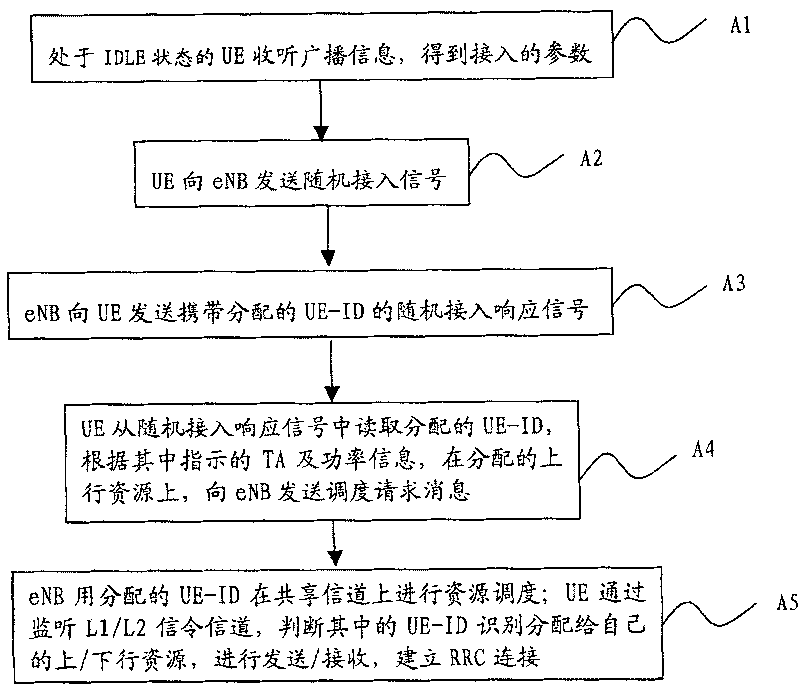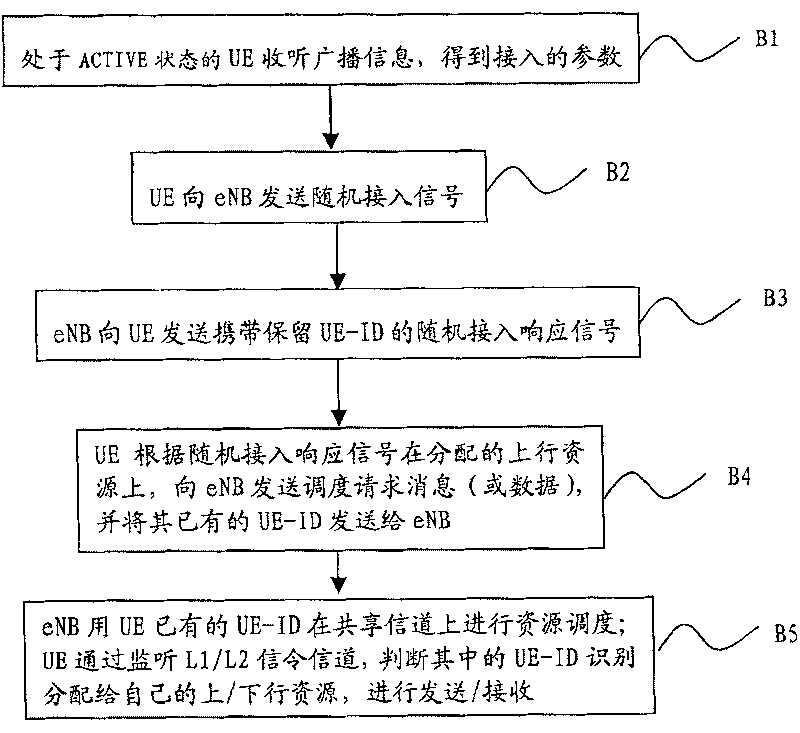Response to random access signal, random access method and mobile communication system
A technology of random access signal and random access response, which is applied in the field of mobile communication system, response of random access signal and random access, can solve the problems of multiple UE-ID resources, complex state control, occupation, etc., and achieve simplification The scheduling process and state control are concise and clear, and the effect of saving system resources
- Summary
- Abstract
- Description
- Claims
- Application Information
AI Technical Summary
Problems solved by technology
Method used
Image
Examples
Embodiment 1
[0034] Embodiment 1. A method for responding to a random access signal. After the eNB receives the random access signal sent by the UE in the IDLE state, L1 calculates the TA transmitted by the UE, and L2 assigns the TA to the UE according to the information carried in the random access signal. Uplink resources, and according to the reason, it is judged that the state of the UE that initiates access is idle, L3 will allocate a UE-ID, and L1 generates a random access response signal, the random access response signal includes UE signature ID, TA, power information and the allocated uplink resources, write the allocated UE-ID into the UE-ID data field, and L1 sends the random access response signal to the UE through a special-format L1 / L2 signaling channel.
[0035] After receiving the random access response signal, the UE extracts the UE-ID number assigned to the UE by the eNB, and sends a scheduling request message to the eNB on the allocated uplink resource according to the TA a...
Embodiment 2
[0036] Embodiment 2, a method for responding to a random access signal. After the eNB receives the random access signal sent by the UE in the ACTIVE state, L1 calculates the TA transmitted by the UE, and L2 assigns the TA to the UE according to the information carried in the random access signal. For uplink resources, according to the reason, it is judged that the state of the UE that initiates access is the active state. L3 does not need to allocate UE-ID, and L1 generates a random access response signal. The random access response signal includes the UE’s signature ID, TA, power information and For the allocated uplink resources, the reserved UE-ID is written into the UE-ID data field, and the L1 sends the random access response signal to the UE through the L1 / L2 signaling channel of a special format.
[0037] After receiving the random access response signal, the UE ignores the reserved UE-ID, and sends a scheduling request message to the eNB on the allocated uplink resource...
Embodiment 3
[0038] Embodiment 3. A method for responding to a random access signal. After the eNB receives the random access signal sent by the UE, L1 calculates the TA transmitted by the UE, and L2 judges that the UE is only for uplink synchronization according to the information carried in the random access signal. Then there is no need to allocate uplink resources to the UE, and L1 sends the UE's signature ID, TA, uplink resources (indicated to be zero) and reserved UE-ID to the UE through the L1 / L2 signaling channel in a special format.
[0039] After receiving the random access response signal, the UE adjusts the uplink synchronization timing according to the TA information in it, that is, ends the random access process.
[0040] Correspondingly, see Figures 1 to 4 , a random access method, comprising the following steps:
[0041] 1. Reserve a UE-ID in the system as a reserved UE-ID, and this reserved UE-ID will not be assigned to any UE
[0042] 2. The UE sends a random access si...
PUM
 Login to View More
Login to View More Abstract
Description
Claims
Application Information
 Login to View More
Login to View More - R&D
- Intellectual Property
- Life Sciences
- Materials
- Tech Scout
- Unparalleled Data Quality
- Higher Quality Content
- 60% Fewer Hallucinations
Browse by: Latest US Patents, China's latest patents, Technical Efficacy Thesaurus, Application Domain, Technology Topic, Popular Technical Reports.
© 2025 PatSnap. All rights reserved.Legal|Privacy policy|Modern Slavery Act Transparency Statement|Sitemap|About US| Contact US: help@patsnap.com



